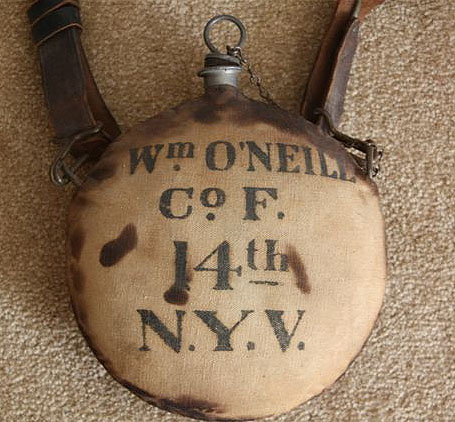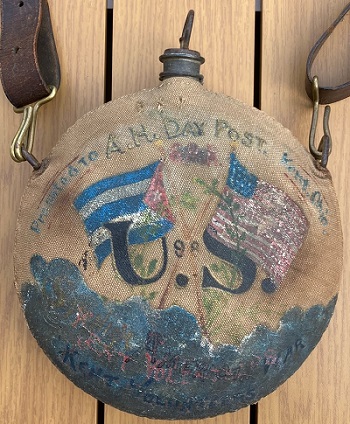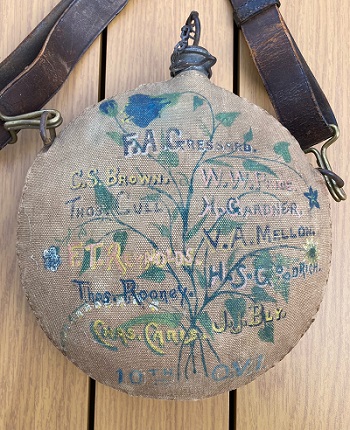

This addresses the canteen used by the American forces during the Spanish American War.
The Canteen:
The standard canteen of the Spanish American War was the Model 1878
canteen, though some volunteer forces may have still been using the
Model 1858 canteen left over from the American Civil War. The most
obvious difference between the models was that the Model 1858 canteen
had an additional guide for the strap at the bottom on the canteen, and
then through the top guide, wound around the bottom of the canteen and
up through the other top guide. The Model 1878 simplified the design,
having the strap simply attach to the two top guides which were now
triangular rings. Below are several examples of the Model 1878 canteen.
A Canteen from the
14th New York Volunteer Infantry:
This canteen belonged to William C. O'Neill, a private in the 14th New York Volunteer Infantry, Co. F. O'Neill was 28 years old when he enlisted on May 2, 1898. He was mustered out on October 27, 1898. The regiment's Armory was located at 8th Avenue & 15th Street in New York. O'Neill's canteen is below, fully intact. The Model 1878 was provided with a canvas cover. In this case, O'Neill's name is stenciled on the canvas cover along with his his regimental designation.

This Model 1878 canteen was used as a
canvas to create a memorial to men who served in the 10th
Ohio Volunteer Infantry. The decorated canteen was presented to
the A. H. Day post of the G.A.R. in Kent, Ohio. The G.A.R. was the
"Grand Army of the Republic," which was the veterans organization for
veterans of the American Civil War. The A. H. Day post was chartered
in December of 1882, and was named for Captain Alfred H. Day who
commanded Co. F of the 7th Ohio Volunteer Infantry during the Civil
War. Day died in 1870 and was buried in the town of Kent. The local
veterans honored Day’s memory by naming their local branch (or post)
of the G.A.R. after him.
Kent, Ohio is basically a suburb of Cleveland, Ohio. It appears that
the men whose names appear on the canteen were also from the Kent,
Ohio area also. Therefore the men whose names are on the canteen were
presenting the decorated canteen to an organization in their hometown,
an organization that likely had fathers and uncles of the men as
members. The words “Kent Volunteers” written in blue at the bottom,
front of the canteen – appears to emphasize the mens' Kent connection.
It would appear that the presentation
between 1898 and 1906 as it appears that John Bly died in 1906. .
Of course, the crossed flags are that of the U.S. and Cuba. The ‘98”
refers to 1898, the date of the Spanish American War.
The men listed on the canteen are as follows:
"C.S. Brown" – Pvt. Clifton S. Brown, Co. B (formed in
Cleveland)
"H.S. Goodrich" – Pvt. Harry S. Goodrich, Co.
I (formed in Cleveland)
"H. Gardner" – Pvt. Howard J. Gardner, Co.
H (formed in Toledo)
"Thos Rooney" – Pvt. Thomas Rooney, Co.
B (formed in Cleveland)
"J.J. Bly" – Pvt. John F. Bly, Co.
B (formed in Cleveland)(note that the regimental
roster lists his as "John F.," the canteen as "John J." It is unclear
which is correct)
"V.A. Mellon" – Pvt. Vernon A. Mellin, Co.
K (formed in Cleveland)(note that the regimental
roster spells the last name as "Mellin," and the canteen as "Mellon."
It is unclear which is correct)
"W.W. Price" – Pvt. Walter W. Price, Co.
C (formed in Cleveland)
"F.T. Reynolds" – Pvt. Francis T. Reynolds, Co.
B (formed in Cleveland)
"F.A. Gressard" – Pvt. Frank A. Gressard, Co.
C (formed in Cleveland)
"Thos Cull" – Pvt. Thomas Cull, Co.
B (formed in Cleveland)
"Chas Caris" – Charles H. Caris, Co.
C (formed in Cleveland)

